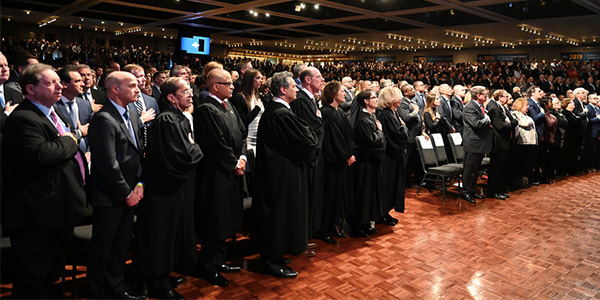By Michael Kuser
New York Gov. Andrew Cuomo signaled last week that his state will this year continue to step up efforts to decarbonize its economy with an eye to spreading the benefits.
“We must accelerate our transition to renewable energy, because the clock is ticking,” Cuomo said in his State of the State address Wednesday in Albany.
The Climate Leadership and Community Protection Act (A8429) signed into law last July calls for 70% of New York’s electricity to come from renewable energy resources by 2030, and for electricity to be 100% carbon-free by 2040. It also nearly quadrupled New York’s offshore wind energy target to 9 GW by 2035.
The law’s clean energy mandates also include doubling distributed solar generation to 6 GW by 2025, deploying 3 GW of energy storage by 2030 and raising energy efficiency savings to 185 trillion BTU by 2025.
Cuomo earlier in the week announced that the New York State Energy Research and Development Authority (NYSERDA) will solicit at least 1 GW of offshore wind energy this year and that a new $20 million Offshore Wind Training Institute at state college campuses on Long Island would begin training 2,500 workers next year.
The state last July awarded offshore wind contracts to Equinor’s 816-MW Empire Wind project and to the 880-MW Sunrise Wind, a joint venture of Ørsted and Eversource Energy. It also plans to commit $200 million to public investments in port infrastructure improvements to serve the new offshore wind industry.
“The creation of the Offshore Wind Training Institute is a critical step in developing the next generation of workers here in New York, who will serve as the backbone for the state’s offshore wind industry and clean energy future for decades to come,” Boone Davis, CEO of Atlantic Offshore Terminals, a developer of offshore wind supply facilities, said in a statement.
Think Big
NYSERDA this year also plans to award development funds to 21 large-scale solar, wind and energy storage projects across upstate New York, totaling more than 1,000 MW of renewable capacity and 40 MW of energy storage capacity.
“People say you have to choose between a strong economy and a healthy planet, but nothing could be farther from the truth,” Cuomo said. “The economy of tomorrow is the green economy.
“This year, let’s go big with an ambitious expansion of electric vehicles and attract the growing industry. It’s a win-win for our environment and our economy,” he said.
Cuomo announced he had chosen Binghamton University professor Stanley Whittingham, winner of the 2019 Nobel Prize in chemistry for his work with lithium-ion batteries, to lead a task force to provide the state with “the most aggressive road map to the e-vehicle future.”
Spectrum News quoted Whittingham on Friday: “The easiest vehicles to convert from internal combustion to electric are fleet vehicles, whether the state can take initiative to start converting hundreds of vehicles to electric, convert all the buses to electric.”
Cuomo said the New York Power Authority (NYPA) should plan and build a statewide functional network of charging stations.
The agencies will work with private industry to ensure that one or more fast-charging locations are available in each of the state’s 10 Regional Economic Development Council regions by the end of 2022, that every travel plaza on the New York State Thruway has charging stations by the end of 2024 and that a total of at least 800 new chargers are installed statewide over the next five years.
“Let’s use our collective government purchasing power and make sure that 25% of public transit bus fleets are electrified by 2025 and 100% by 2035,” Cuomo said. “Let’s make $100 million in Green Bank financing available to locate or expand EV manufacturers and suppliers in the state.”
The Green Bank of New York is a state-sponsored investment fund that helps leverage private financing for clean energy industry companies.
NYSERDA and NYPA will provide additional incentives to build more renewable projects and build them faster, focusing on opportunities upstate, and they will build new transmission lines to get the power to consumers who need it downstate, the governor said.
New York also will work this year to reduce fossil fuel consumption in buildings, with NYSERDA launching a $30 million retrofit program to demonstrate solutions for high-profile commercial and multifamily buildings.
NYSERDA will ask property owners, developers, equipment manufacturers and energy efficiency providers to propose ways to cut energy consumption and greenhouse gas emissions from buildings.



